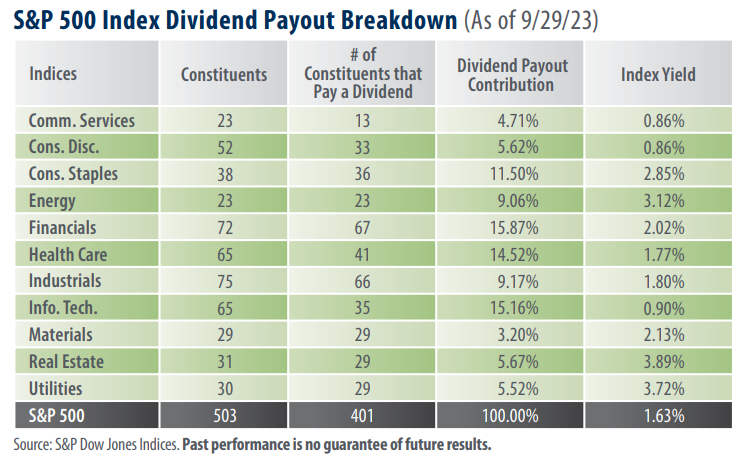
View from the Observation Deck
Companies often return capital to their shareholders through dividend distributions. The practice is so common that as of 9/29/23, 401 of the 503 constituents in the S&P 500 Index (“the Index”) distributed a cash dividend to their equity owners. In addition to acting as a conduit for return of capital, dividend distributions account for a significant portion of the Index’s total return. According to data from Bloomberg, dividends contributed to over 38% of the total return of the Index over the 95-year period between December 30, 1927, and December 30, 2022.
• Data from Bloomberg indicates that the dividend payments from S&P500 Index constituents totaled $67.57 per share (record high) in 2022, up from $60.54 (previous record high) in 2021. As of 10/11/23, the estimates for 2023 and 2024 were $71.32 and $75.47, respectively.
• Of the 11 major sectors that comprise the S&P 500 Index, eight of them had yields above the 1.63% generated by the Index over the period captured in the table. Financials, Information Technology, and Health Care contributed the most to the Index’s dividend payout at 15.87%, 15.16% and 14.52%, respectively.
• The payout ratio for the S&P 500 Index stood at 38.21% on 9/29/23. A dividend payout ratio between 30% and 60% is typically a good sign that a dividend distribution is sustainable, according to Nasdaq.
• Many investors view changes in dividend distributions as an indication of strength and or weakness in the underlying company. For that reason, companies will often avoid decreasing or suspending their dividend payout. Year-to-date (YTD) through 9/29/23 a total of 20 dividends were reduced, and four companies suspended their payouts. For comparative purposes, not a single dividend was suspended in 2022, and only five dividend reductions were recorded over the period.
• Click here to access our last dividend profile post on 4/27/23.
Takeaway
Dividend distributions continue to be one of the most efficient methods by which companies can return capital to their shareholders. In 2023, the companies that comprise the S&P 500 Index are forecast to distribute a record $71.32 per share to their equity owners. Additionally, dividend distributions have contributed meaningfully to the performance of the S&P 500 Index, over time. In the 95-year period between December 30, 1927, and December 30, 2022, more than 38% of the total return of the Index came from dividend distributions, according to data from Bloomberg. That said, investors may want to keep a close eye on dividend sustainability. The Index has experienced 20 dividend reductions so far in 2023, the fourth-highest total for dividend reductions over the past 20 years. For comparison, the Index suffered 68, 40, and 27 dividend cuts, respectively, in 2008, 2007, and 2020.



